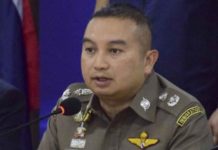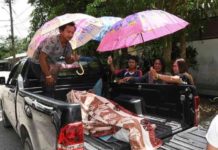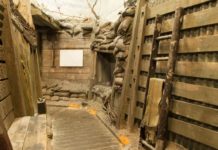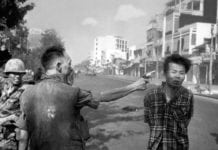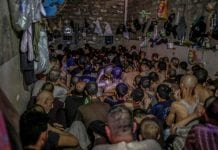
Ten-year-old Sao Yotkantha was helping his father in their rice field when he heard the roar of an airplane unusually close. He looked up and saw a twin-engine plane hit the ground a half-mile away and burst into flames.
It was World War II, and the crash of the U.S. aircraft was the biggest event in the history of Baan Mae Kua, a small village in northern Thailand.
“I heard a rumbling sound and saw a flying boat, as Thais called it back then,” recalled an animated Sao, now 87. “It was really close. It wasn’t like any sound I heard before, and then I saw it go down.”
The airplane, a P-38 Lightning, was on a reconnaissance mission over Thailand and Burma, now Myanmar, when it was most likely struck by lightning and fell from the sky. Heavy rains extinguished the blaze.
Sao rushed to the scene with his father, but all that was left of the pilot was his torso. It was the first time he had seen a foreigner, he said, and he was struck by the man’s reddish-blond hair.
Seventy-seven years later, in another big event for the remote community, a team from the U.S. military arrived in March to excavate the probable crash site in Lampang province in the hope of finding enough of the pilot’s remains to confirm his identity.
Nine Americans drawn from the Army, Air Force and Navy, as well as civilian contractors, worked alongside 30 Thai workers hired from the village to turn the site into an archaeological dig. Before wrapping up the excavation in April, they found fragments certain to be from a U.S. aircraft and small pieces of what might be human bone.
One find, a metal plate, said “Army Air Corps,” a forerunner of the Air Force. A piece of another data plate read, “Aviation Corporation” and “New York, N.Y.,” but provided no other clues.
“I am very hopeful,” said Mindy Simonson, a civilian archaeologist who supervised the dig. “What we have found so far are all good indicators.”
The search for the pilot’s remains is part of an effort by the United States to recover missing service members and fulfill the military’s promise to bring everyone home. More than 72,000 people are listed as missing in foreign conflicts, mainly World War II.
The Hawaii-based Defense POW/MIA Accounting Agency has the job of finding the last location of the missing, conducting excavations and identifying remains. The process can take years. With an annual budget of $131 million, the agency has identified more than 1,200 missing service members since 2015.
The P-38, with its distinctive twin tails, crashed Nov. 5, 1944, in a forested area just outside Baan Mae Kua. The village was home to only a few hundred residents. It had no electricity; no one owned a car or motorbike. The local school ended in third grade because there was no fourth-grade teacher.
Scrap metal was valuable, so villagers hauled away most of the plane’s wreckage on carts drawn by water buffalo. It is unclear what happened to the torso.
The crash site eventually became a rice field. Older residents refer to it as Deadman’s Torso Flat. Younger people have begun calling it Fallen Plane Field.
The village has modernized since the war, but life there remains much the same. Now about 2,000 people live in the village, growing rice and cassava and raising cattle. Many families have called the village home for generations.
Along narrow lanes, one- and two-story houses lie half-hidden behind cinder block walls. Gardens boast banana, papaya, tamarind and mango trees. These days, the school goes through sixth grade; a junior high school is 5 miles away. A few students go on to university and return as teachers.
Older residents say they grew up with stories about the U.S. aircraft.
“Since I was a child, as far back as I can remember, I heard about that plane,” said Bai Norkaew, one of the villagers paid $12 a day to help excavate the site.
With the help of a metal detector, the team planted hundreds of little white flags to mark the sites of possible airplane debris. Excavation revealed variations in the soil layers, indicating an impact crater. Using water to sift through the dense clay, the team searched for pieces of metal, glass or bone, no matter how small, that might have come from the crash. At times, the temperature rose above 100 degrees.
Wearing a gray T-shirt wrapped around her head so that only her eyes showed, Bai, 70, was happy to have the work. “I am still strong,” she said.
The pay was better than the $9 a day she got for working in the cassava fields, and so were the conditions, with a break every hour and a shorter workday. She also liked performing a good deed for the deceased.
“It makes sense in a traditional Thai way,” she said. “Bring the body back to make merit and to make good karma for the pilot.”
The village’s oldest resident is Fong Inma, who recently turned 99. She is hard of hearing but active, climbing stairs at home without a handrail and riding on the back of a motorbike with her granddaughter and 9-year-old great-granddaughter.
She has a vivid recollection of the U.S. plane crash. At the time, she was 21, pregnant and at home, weaving. “I didn’t see it crash; I just heard it,” she said. “I was really scared. A lot of people were scared.”
She visited the site the next day with her husband and her father-in-law, the village chief, and saw the pilot’s torso. The wreckage was still too hot to approach, she recalled. Many people had come to view the scene, and she helped make food for them.
She gave birth to a son weeks later and named him Khrueang — a Thai word for machine — after the flying machine that crashed. At the time, Thailand’s government was collaborating with the Japanese, and Royal Thai Air Force fighters were flying into combat from an airfield in the vicinity.
The pilot who is believed to have crashed had a reputation for taking unnecessary risks, and when he got caught in the storm may have been flying at a low elevation to better photograph enemy targets, Daniel Jackson, a historian, wrote in his 2021 book, “Fallen Tigers.”
While the crash site was well known to villagers, the location came to the attention of the U.S. agency only in 2018 thanks to three history buffs: Jackson; Hak Hakanson, an American living in Thailand; and retired Air Chief Marshal Sakpinit Promthep, a Royal Thai Air Force Museum historian.
Last week, the agency held a repatriation ceremony at Utapao Air Base before sending items recovered during the dig to its Hawaii laboratory. Confirming the pilot’s identity will require detailed analysis and could take months, the agency said.
“It’s good to know there are pieces of an American plane here,” said Capt. Jenavee Viernes of the Air Force, who directed the search operation. “But we don’t know yet if it’s the plane we are looking for.”
This article originally appeared in The New York Times.




